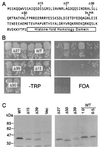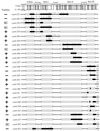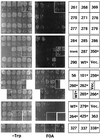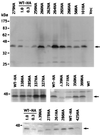Analysis of primary structural determinants that distinguish the centromere-specific function of histone variant Cse4p from histone H3
- PMID: 10454560
- PMCID: PMC84538
- DOI: 10.1128/MCB.19.9.6130
Analysis of primary structural determinants that distinguish the centromere-specific function of histone variant Cse4p from histone H3
Abstract
Cse4p is a variant of histone H3 that has an essential role in chromosome segregation and centromere chromatin structure in budding yeast. Cse4p has a unique 135-amino-acid N terminus and a C-terminal histone-fold domain that is more than 60% identical to histone H3 and the mammalian centromere protein CENP-A. Cse4p and CENP-A have biochemical properties similar to H3 and probably replace H3 in centromere-specific nucleosomes in yeasts and mammals, respectively. In order to identify regions of Cse4p that distinguish it from H3 and confer centromere function, a systematic site-directed mutational analysis was performed. Nested deletions of the Cse4p N terminus showed that this region of the protein contains at least one essential domain. The C-terminal histone-fold domain of Cse4p was analyzed by changing Cse4p amino acids that differ between Cse4p and H3 to the analogous H3 residues. Extensive substitution of contiguous Cse4p residues with H3 counterparts resulted in cell lethality. However, all large lethal substitution alleles could be subdivided into smaller viable alleles, many of which caused elevated rates of mitotic chromosome loss. The results indicate that residues critical for wild-type Cse4p function and high-fidelity chromosome transmission are distributed across the entire histone-fold domain. Our findings are discussed in the context of the known structure of H3 within the nucleosome and compared with previous results reported for CENP-A.
Figures







Similar articles
-
CSE4 genetically interacts with the Saccharomyces cerevisiae centromere DNA elements CDE I and CDE II but not CDE III. Implications for the path of the centromere dna around a cse4p variant nucleosome.Genetics. 2000 Nov;156(3):973-81. doi: 10.1093/genetics/156.3.973. Genetics. 2000. PMID: 11063678 Free PMC article.
-
The N terminus of the centromere H3-like protein Cse4p performs an essential function distinct from that of the histone fold domain.Mol Cell Biol. 2000 Sep;20(18):7037-48. doi: 10.1128/MCB.20.18.7037-7048.2000. Mol Cell Biol. 2000. PMID: 10958698 Free PMC article.
-
Histone-histone interactions and centromere function.Mol Cell Biol. 2000 Aug;20(15):5700-11. doi: 10.1128/MCB.20.15.5700-5711.2000. Mol Cell Biol. 2000. PMID: 10891506 Free PMC article.
-
The Elusive Structure of Centro-Chromatin: Molecular Order or Dynamic Heterogenetity?J Mol Biol. 2021 Mar 19;433(6):166676. doi: 10.1016/j.jmb.2020.10.010. Epub 2020 Oct 14. J Mol Biol. 2021. PMID: 33065112 Review.
-
Is there a unique form of chromatin at the Saccharomyces cerevisiae centromeres?Bioessays. 1995 Aug;17(8):669-72. doi: 10.1002/bies.950170802. Bioessays. 1995. PMID: 7661847 Review.
Cited by
-
CENP-A, -B, and -C chromatin complex that contains the I-type alpha-satellite array constitutes the prekinetochore in HeLa cells.Mol Cell Biol. 2002 Apr;22(7):2229-41. doi: 10.1128/MCB.22.7.2229-2241.2002. Mol Cell Biol. 2002. PMID: 11884609 Free PMC article.
-
The histone fold domain of Cse4 is sufficient for CEN targeting and propagation of active centromeres in budding yeast.Eukaryot Cell. 2004 Dec;3(6):1533-43. doi: 10.1128/EC.3.6.1533-1543.2004. Eukaryot Cell. 2004. PMID: 15590827 Free PMC article.
-
Adaptive evolution of Cid, a centromere-specific histone in Drosophila.Genetics. 2001 Mar;157(3):1293-8. doi: 10.1093/genetics/157.3.1293. Genetics. 2001. PMID: 11238413 Free PMC article.
-
A 330 kb CENP-A binding domain and altered replication timing at a human neocentromere.EMBO J. 2001 Apr 17;20(8):2087-96. doi: 10.1093/emboj/20.8.2087. EMBO J. 2001. PMID: 11296241 Free PMC article.
-
Structural basis for recognition of centromere histone variant CenH3 by the chaperone Scm3.Nature. 2011 Apr 14;472(7342):234-7. doi: 10.1038/nature09854. Epub 2011 Mar 16. Nature. 2011. PMID: 21412236 Free PMC article.
References
-
- Bloom K S, Carbon J. Yeast centromere DNA is in a unique and highly ordered structure in chromosomes and small circular minichromosomes. Cell. 1982;29:305–317. - PubMed
-
- Fitzgerald-Hayes M, Clarke L, Carbon J. Nucleotide sequence comparisons and functional analysis of yeast centromere DNAs. Cell. 1982;29:235–244. - PubMed
Publication types
MeSH terms
Substances
Grants and funding
LinkOut - more resources
Full Text Sources
Other Literature Sources
Molecular Biology Databases
